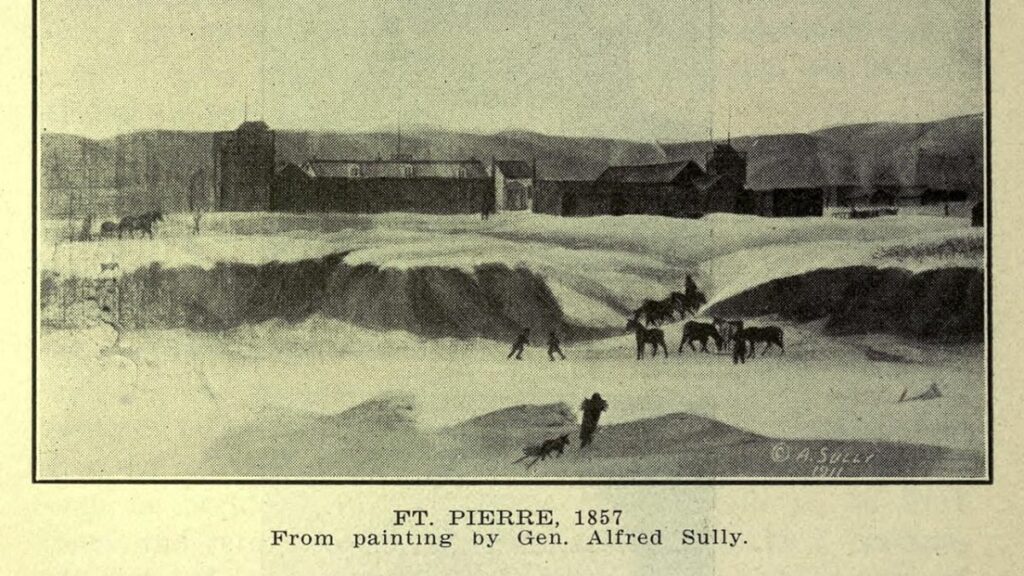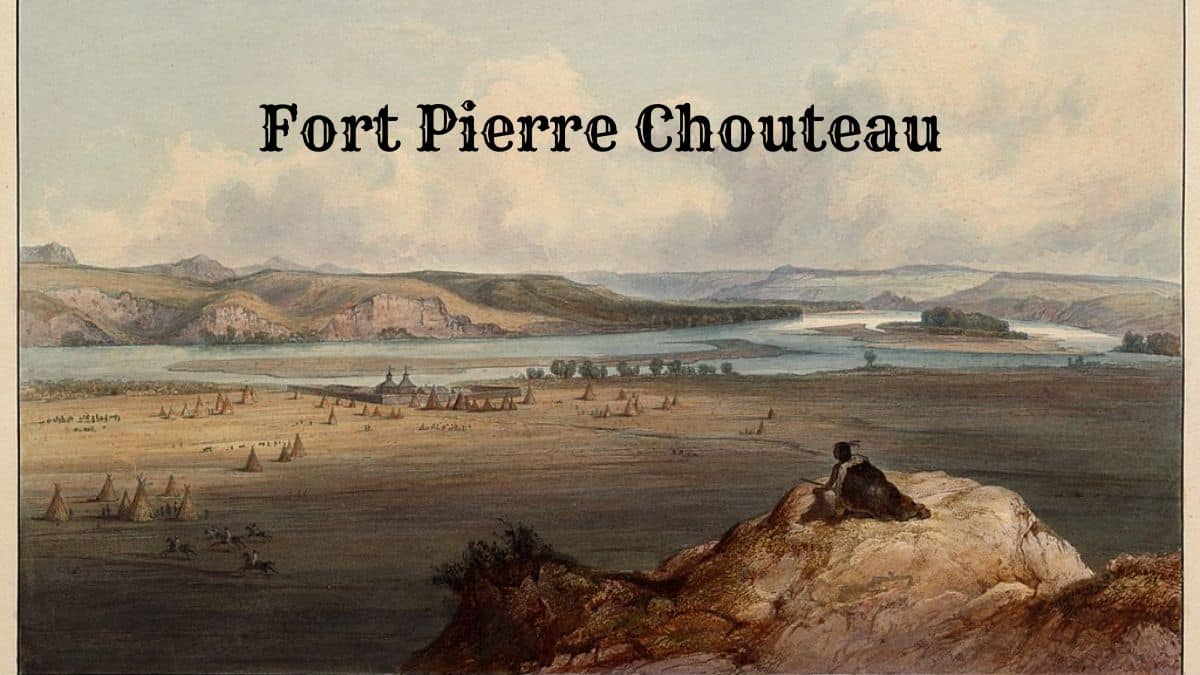Fort Pierre Chouteau stands as a captivating piece of South Dakota history. It offers a glimpse into early 19th-century American expansion.
Designated a National Historic Landmark, this site on the Missouri River once served as a bustling center of trade and diplomacy.
Located in South Dakota, Fort Pierre Chouteau played a significant role in the fur trade and interactions with Native American tribes.
Visitors today can explore the remnants of this historic site and learn about its impact on the region’s development.
Whether you’re a history enthusiast or simply curious about the past, Fort Pierre Chouteau offers a unique experience.
Its strategic location along the Missouri River highlights its importance in the history of American westward expansion.
History of Fort Pierre Chouteau (South Dakota)

Fort Pierre Chouteau played a significant role in the early American fur trade. It especially influenced interactions with Native American tribes and European markets.
This section details its establishment, influential figures, and strategic importance on the Western Frontier.
Establishment and Early Operations
The American Fur Company, led by John Jacob Astor, established Fort Pierre Chouteau in 1832 near the Upper Missouri River. This trading post was crucial for exchanging goods like buffalo hides with Native Americans.
The fort also facilitated significant commerce between St. Louis and the Great Plains, serving as a key node in the fur trade network.
Euro-Americans and Native Americans frequently visited the fort for trade and supplies. The establishment marked a pivotal point in trade relations, enabling a steady fur flow from the American West to European markets.
The accessibility and strategic location of Fort Pierre made it an essential trading hub.
Pierre Chouteau Jr. and The Expansion
Pierre Chouteau Jr., an influential figure and son of Jean Pierre Chouteau, played a vital role in expanding operations. He managed the fort under the umbrella of the American Fur Company.
His leadership saw increased fur trade activities along the Upper Missouri, broadening the fort’s reach and influence.
He spearheaded several expansions that increased the fort’s capacity to manage more goods and people.
This period saw Fort Pierre acting as a launch point for interactions not only with local Native American tribes but also explorations towards the Oregon Trail.
Chouteau Jr.’s vision allowed for a more extensive and robust fur trading network.
Role in the Western Frontier
The fort was strategically positioned as a haven for traders and settlers moving westward.
It was located on the Fort Pierre-Deadwood Trail, linking it with other vital trading and settlement areas. This location made it an indispensable part of expansion into the Western Frontier.
Interaction with Native American tribes was complex but generally centered around mutually beneficial trade.
Euro-Americans relied on the fort for supplies and security during their travels, making it a cornerstone of Western expansion.
As a result, Fort Pierre Chouteau became a touchstone in the narrative of the American West.
Explore More: 10 Historic Forts in South Dakota: A Comprehensive Guide
Trade and Commerce
Fort Pierre Chouteau was a significant hub in the fur trading economy. It was a critical point for the exchange of goods and the fosterment of strategic relationships.
Its location on the Upper Missouri River made it ideal for commercial activities involving various goods and traders.
The Fur Trading Economy
Fort Pierre Chouteau played a vital role in the fur trading economy of the Great Plains. American and European traders flocked to the fort to procure buffalo robes, pelts, and other valuable furs.
The American Indians were key participants in this trade, bringing highly sought-after furs in Eastern markets.
The fur trade at Fort Pierre fostered an interdependence between Native Americans and European traders.
This interdependence extended beyond commerce, including cultural exchanges and alliances that impacted the region for years.
Goods and Exchange
The exchange of goods at Fort Pierre Chouteau encompassed a diverse array of items.
Traders brought guns, cloth, beads, sugar, salt, tobacco, and coffee to exchange with Native Americans.
In return, they received buffalo robes and animal pelts, then shipped to Eastern markets.
These exchanges formed the backbone of the economy in the region, providing essential resources for both parties.
American Indians gained access to European goods that improved their daily lives, while traders secured valuable furs essential to their businesses.
Strategic Importance of Fort Pierre
Strategically located on the banks of the Upper Missouri River, Fort Pierre Chouteau served as a gateway for commercial activities.
Its access to the Missouri River facilitated the transport of goods to and from the fort, ensuring a steady trade flow.
The fort’s position made it a central trading center, drawing traders from afar.
Establishing commercial alliances and relationships with native tribes further solidified its importance.
Fort Pierre was instrumental in shaping the region’s trade dynamics and fostering long-term economic relationships between diverse communities.
Military and Strategy
Fort Pierre Chouteau held a pivotal role in national defense, serving key military purposes and hosting several strategic endeavors.
The Army’s Role and Transformation
The United States Army transformed the fort from a trading post into a strategic military outpost, providing a crucial base for operations in the Western Department.
The Army’s presence aimed to maintain peace with Native American tribes and protect nearby settlements.
This transformation involved significant upgrades to its facilities and increased military activity, becoming an essential hub for soldiers and supplies.
Fortifications and Architecture
The fort’s architecture reflected its strategic importance. A robust stockade surrounded the fort, and strategically placed buildings inside included barracks, storerooms, and officer quarters.
Regular repairs and improvements were undertaken to maintain structural integrity.
Fort Pierre Chouteau was modeled after Fort Tecumseh and emphasized strong defensive capabilities. The fortifications ensured it could withstand potential attacks and provided a secure base for military operations.
Encounters with Explorers
Prominent explorers and naturalists visited Fort Pierre Chouteau, contributing to its historical significance.
George Catlin, Prince Maximilian, and John J. Audubon were among the notable figures who documented their experiences at the fort.
These encounters provided valuable insights into the region’s cultural and natural history. Their records offered unique perspectives on the fort’s role in the broader context of exploration and scientific discovery.
Cultural Interactions
Fort Pierre Chouteau was a significant site where diverse cultures intersected, resulting in varied interactions.
Key aspects include trade relationships with Native tribes, the influence of European practices, and the artifacts and documentation that have preserved these interactions.
Trade Relations with Native Tribes
Fort Pierre Chouteau was a central hub for trade with Native American tribes, particularly the Sioux. Trappers and traders exchanged material goods such as fur, tools, and textiles.
The mutual dependency between the Fort’s residents and the tribes fostered a unique interdependence.
The Fur Business was crucial, and the tribes supplied furs in exchange for products that enhanced their daily lives.
Despite the beneficial aspects of trade, conflicts occasionally erupted over territorial encroachment in Lakota country.
European Influence
The fort saw the significant impact of European culture, primarily through French explorers and traders post-Louisiana Purchase.
Euro-American culture influenced various aspects of life at Fort Pierre Chouteau, from clothing styles to construction methods.
The Dakota Territory evolved under this blend of influences.
European practices altered traditional lifestyles for many American Indian cultures, reshaping social and economic structures.
This period marked an era of change, blending old traditions with new European methods and tools, leading to cooperative and contentious interactions.
Artifacts and Documentation
Many cultural artifacts from this era have been preserved, offering insight into daily life and interactions at Fort Pierre Chouteau.
Items such as tools, weapons, and trading goods reflect the exchange of culture and goods.
Documentation from the period includes letters, diaries, and official records detailing the dealings between trappers, traders, and Native tribes.
These documents are invaluable for understanding the relationships and dynamics at play. They capture legends of America, detailing aspects of American Indian culture and illustrating the complex nature of these interactions.
Preservation and Legacy
Fort Pierre Chouteau holds a significant place in American history. Its preservation and legacy showcase efforts to recognize and conserve this historic site.
National Recognition and Conservation
The site of Fort Pierre Chouteau has been acknowledged as a National Historic Landmark. This designation emphasizes its importance in the history of the Northern Great Plains.
Fort Pierre Chouteau is also listed on the National Register of Historic Places, providing further protection and recognition.
The State Historical Society has played a crucial role in its preservation, organizing efforts to maintain and protect the site.
Conservation work often includes excavations to unearth artifacts and better understand the fort’s historical context.
Remains and Site Management
Visible remains of the fort can still be seen, providing a tangible connection to its storied past.
Efforts to maintain these remains are ongoing, with a comprehensive management plan in place.
A stone marker and monument now stand at the site, commemorating its historical importance. These markers highlight key dates and events associated with the fort’s history.
Regular inspections and maintenance ensure that the site remains preserved for future generations. This includes measures to prevent erosion and vandalism.
Prominent Figures and Chronicles
Charles and Frederick Behman were notable merchants who played significant roles in the fort’s history. Their contributions to trade and commerce were vital during the fort’s operational period.
Various historical accounts and legends chronicle the fort, offering insights into its inhabitants’ daily lives and the strategic importance of the location.
These chronicles help paint a vivid picture of the fort’s role in American expansion. Accounts often highlight interactions between traders, Native American tribes, and military personnel.
They emphasize the fort’s function as a hub of diverse activities and cultural exchanges.

Cory is a website owner and content creator who enjoys fishing, history, coin collecting, and sports, among other hobbies. He is a husband and father of four.
Romans 15:4 For whatever was written in former days was written for our instruction, that through endurance and through the encouragement of the Scriptures we might have hope.

